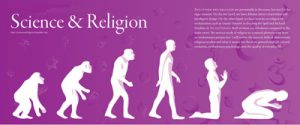Human Evolution: A Three Stage Religiously Civilized Species
Human Evolution: A Three Stage Religiously Civilized Species
Rabbi Allen S. Maller
A great deal of unnecessary conflict and misunderstanding between evolutionists and religious thinkers has been caused by the careless use of the terms ‘human’ and ‘man’ to describe the increasing number of fossil finds of tool using biped primate species some, but not most of them, ancestral to Homo Sapiens.
I shall try to refer to each distinct species by its scientific name only. Most humans think that the name ‘human’ or ‘mankind’ should be reserved only for our own species-Homo Sapiens.
Not using the word ‘human’ and ‘man’ carelessly to name many different species would help resolve some of the conflict between most Darwinists and many religious people. Indeed, some evolutionists now use the term ‘people’ to specify Modern Homo Sapiens.
In addition, religious people can find new insights into the Qur’anic verses about humanity, and the Torah’s teachings in the Book of Genesis, by understanding the evolution of Homo Sapiens spirituality.
Fossil evidence shows Homo Sapiens (HS) evolved physically 150-200,000 years ago. This is about 50-150,000 years after the evolution of Homo Neanderthal (HN) who inhabited Europe and parts of north western Asia from about 300,000 to 35,000 years ago. HN were well adapted to the cold; were very muscular and had slightly larger brains than HS.
Genetic analysis of the Y chromosomes of 1244 modern men from 26 populations around the world, using data generated by the 1000 Genomes Project published in Nature Genetics (4/25/16) shows how all 1244 Y chromosomes relate to one another. As expected, they all descend from a single male (Adam) who lived approximately 190,000 years ago. (Genetic data from female X chromosomes indicate Eve lived several thousand years earlier.)
Increasing mental capacities among HS were productive from a tool making and social interacting perspective, but these same increasing mental capacities sometimes had negative side effects such as anxiety, stress, self imposed tension and neurosis.
Any genetic adaptation that increased individual and community levels of social and individual trust, confidence, and optimism would in turn help correct or ameliorate individual mental disabilities due to negative mental states.
Such genes would be selected for, and would spread throughout that population. If that gave the group better survival rates and increased population growth, the genes would keep spreading.
Spiritual activities among HS have evolved over the last 80-140,000 years. If one takes seriously the Biblical claim that humanity was created in the Divine image, or the Qur’an’s statement that humans were created to be vice-regents with God: spiritual evolution testifies to the creation of creatures who are social co-creators of purpose driven non-material responses to environmental and social challenges.
The evolution of spiritual activities that enhance the successful survival of humanity is not only concerned with enhancing the survival of our own species. With the recent domestication of plants and animals; and the very recent industrial revolution, humans acquired a great deal of responsibility for the evolution and survival of many of the species on the planet itself. Thus the behavior of religious people themselves now becomes a factor in the evolution of life on earth.
The first challenge to self-conscious, articulate HS is also the ultimate one: death. Homo Sapiens is the only living species that knows in advance that death is inevitable. Genesis 2:17 teaches “on the day you eat it (the tree of knowledge of good and evil you will know) you will surely die.”
Elephants, Chimpanzees and Orangutans have been observed to mourn for a dead child, but no other living species practices ritual burials with symbolic grave goods. The intelligent minds of HS responded to the death of loved ones by creating funeral rites and rituals of ancestor worship.
Evidence from Qafzeh cave in northern Israel of ritual burial and grave goods (red ocher and mollusk shells of an inedible species) goes back 100 -120,000 years or more.
It is also possible that nomadic hunter-gatherer bands in Africa used the skulls of important individuals in community rituals over many centuries. Two HS skulls from Herto in Ethiopia, well worn through handling, have been dated to more than 140,000 years ago. These ritual activities strengthened feelings of kinship within and among hunter-gather bands enabling them to be more stable, grow larger and survive the potential split of the band when its number one leader died.
It is not just chance that the first moral issue that HS become self-aware of, way back in the Garden of Eden, was being naked. HS is the only living species that clothes itself. (Genesis 3:7) Evidence of textiles from more than 20,000 years ago has been found in the cold climates of ice age Europe. However, the origins of clothing in Africa are the not the result of ice age climate but the result of concepts of modesty.
Self-aware intelligent minds became moral minds and then became modest minds. Recent DNA studies of body lice that must lay their eggs in clothing, show that these lice evolved from pubic lice that adapted to clothing that covered the pubic area. According to a 2003 study led by Mark Stoneking, a geneticist at the Max Planck Institute in Leipzig, Germany, this genetic adaptation took place 42-72,000 years ago.
A newer study recently published in the January, 2011 issue of Molecular Biology and Evolution, indicates a date of separation between body and clothing lice of 83.000-170.000 years ago. So HS have been clothing themselves for about 100-140,000 years; which is long before HS exited Africa and the Middle East and started to live in very cold climates.
Thus, long before rules about property became important, rules of probity were important, and became another source of religious evolution.
The age when sexual modesty became evident is important. The Bible states that the first thing humans became aware of after internalizing the knowledge of good and evil was their nakedness. If this occurred 70-100,000 years ago it fits right in with increasing evidence of more rapid spiritual and technological development.
The tool kit of Homo Erectus, a species prior to HS, changed very slowly over the course of hundreds of thousands of years. Early HS tools changed more quickly over the course of tens of thousands of years. But about 60-90,000 years ago the pace of change increased substantially for HS both technologically and spiritually.
Burial grave goods and early art paintings are signs of abstract thought. Ochre was one of the first paints used by Homo Sapiens. A 70,000-year-old ochre cave painting found in South Africa is thought to be the oldest work of art in the world.
Modern Homo Sapiens, based on the Bible’s criteria for what it means to be a human being created in the image of God, originated about 50-100,000 years prior to Adam’s first farming activities, about 10-12,000 years ago. (Genesis 3:10)
Thus, Homo Sapiens developed in three states. The first stage was anatomically modern Homo Sapiens; whose bones and body looked like ours.
The second stage was culturally modern Homo Sapiens; whose art looks like ours.
The third stage was spiritually modern (Adam and Eve) Homo Sapiens; whose religious structures and rituals begin to look like ours.
With the development of agricultural villages and then writing, third stage Adam and Eve can be inspired by prophets to give birth to the revealed religions that determine, for both weal and woe, so much of human life today,
And this is why Genesis tells us that only in later generations did the descendants of Adam begin to use the name of God written in the Bible (YHVH Genesis 4:26) “Then men began to call upon the name of YHVH-the LORD” Thus, Adam and Eve are the archetypes of third stage ‘civilized by religion’ Homo Sapiens.
Almost 10-15,000 years ago, our ancestors began the greatest transformation in human history, abandoning the nomadic lifestyle they had lived for thousands of generations in favor of farming, and then much later, permanent villages with monumental structures for spiritual uses. The origin of this “Neolithic revolution” once seemed clear: food. Farming was more efficient than foraging and so people gravitated towards it. Cities, writing and organized religion soon followed.
But in recent years, the discovery of Gobekli Tepe, a site just north of today’s Turkish Syrian border has changed things. Gobekli Tepe is a cluster of 11,000 year old structures with spectacular statues and other monumental architecture, which the archaeologists who found it, interpreted as having a ritual ceremonial purpose.
But the people who built them were nomads, not farmers. So the radical suggestion now is that it was not agriculture that drove the Neolithic revolution, but religion. Some archaeologists oppose this idea, arguing that the ruins were once surrounded by dwellings that did not survive.
But the religious ceremonial-first model is now in the ascendancy, supported by further evidence unearthed in the Levant. Recent news reported in New Scientist (3/26/15) is that another ancient civilization – the Maya – may also have had spiritual roots. Their oldest city, Ceibal, seems to have begun as a place where hunter-gatherers assembled for religious festivals (pilgrimage-Hajj).
The parallels are intriguing. Maya civilization developed in total geographical isolation from the Old World, and several thousand years later. If it followed the same path, perhaps that tells us something profound about the importance of religion in producing human cultural evolution.
Many secularists dislike the idea that spiritual desires drove the rise of stage three Homo Sapiens human civilization. They fret that it will reinforce or restore religion’s central place in society. Even worse, it might mean that the Marxist influenced view that the economic means of production is the primary driving force in the development of human society and civilization; is factually false.
Thus in recent years, the disciples of a non-orthodox Darwin have been steadily been moving closer and closer to the disciples of a non-orthodox Moses.
For Further Reading:
Before the Dawn
Nicholas Wade Penguin Books 2006
Darwin’s Cathedral: Evolution, Religion, and the Nature of Society
David Sloan Wilson University of Chicago Press 2002
The Faith Instinct
Nicholas Wade Penguin Books 2009
The God Part of the Brain
Matthew Alper Sourcebooks Naperville Ill. 2006
Religion Explained: The Evolutionary Origins of Religious Thought
Pascal Boyer Basic Books 2001
The Origin and Evolution of Cultures
Robert Boyed and Peter Richerson Oxford University Press 2005
The Spiritual Brain
Mario Beauregard and Denyse O’Leary Harper One N. Y. 2007
Why God Wont Go Away: Brain Science and the Biology of Belief
Newberg, D’Aquili and Rause Ballantine Books N.Y. 2001
Wondrous Healing: Shamanism, Human Evolution and the Origin of Religion
J. McClennon Northern Illinois University Press 2002


